Inter-institutional Water Management Project Receives Partnership Award
March 9, 2012 | CCST Newsroom | Contact: M. Daniel DeCillis

The Landsat 7 satellite in orbit. The Water Management in California partnership is using Landsat images to provide real-time assessment of water demand for agricultural use in a pilot program at 15 farms. Image courtesy of NASA.
The Federal Laboratory Consortium – Far West Region has awarded the 2011 Outstanding Partnership Award to a multi-institutional collaboration including NASA Ames Research Center, California State University-Fresno, California State University-Monterey Bay, and the University of California Davis, as well as the California Department of Water Resources. The project, “Water Management in California: A NASA-CDWR Partnership,” uses cutting-edge technology to help assess water demand for agricultural irrigation.
“The project uses a satellite based, remote sensing platform to help refine irrigation scheduling,” said David Zoldoske, Executive Director of Water Resources and Policy Initiatives at California State University and a CCST Senior Fellow. “We’ve completed the first year of testing at fourteen farms, with ‘ground-truthing’ to check the accuracy of the model for water demand being produced by the satellite data, and have several more years of testing before finally verifying the approach.”
The project is a timely collaboration that fits in with the broader road map for water use that California needs to be developing, according to CCST. Water use was one of three primary infrastructure areas CCST focused on in its 2011 “Innovate to Innovation” project, which analyzed the state’s overall innovation ‘ecosystem’ at the behest of the state legislature in order to determine how best to sustain and support California’s high-tech innovation. “California’s Water Future: A Science and Technology-Based Water Innovation Road Map” calls for a broad inter-institutional and cross-disciplinary collaboration on a plan that looks at how science and technology can most effectively impact the state’s water management over the next fifty years.
“This partnership fits right in with the concept of developing a road map which leverages technology in new and highly effective ways,” said Zoldoske. “While water is only one element in optimizing crop yield, providing field level, localized data can help optimize for regional variables such as localized weather patterns and help maximize the efficiency of the irrigation system.”
Using satellite data to provide more accurate information will be an important step in quantifying agricultural water use and efficiency, which has presented policy makers with a host of challenges including contradictory reports and data on demand and supply. However, while the project offers the potential for improved water use efficiency, the overall likelihood for producing “new water” through more efficient agricultural practices is limited, according to the California State University, Fresno’s Center for Irrigation Technology (CIT). In a November 2011 report, the CIT estimated that the estimated potential “new water” from greater agricultural water use efficiency represents no more than 0.5 percent of California’s total water use.
“This partnership is a valuable example of how remote sensing can contribute the potential for improved water use efficiency, and it is an honor for all of us to be recognized by the FLC,” said Zoldoske. “However, improving management of water use is only one element needed in an overall road map. The state also needs to continue work on supply-side management – expand its ability to effectively store and manage the State’s water supply from all sources to achieve long-term sustainability.”






